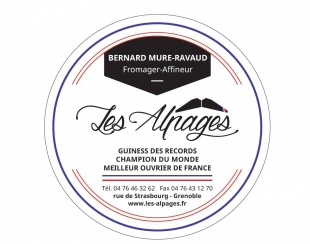Grenoble, France
2016-09-12
2016-09-16
Welcome Wine & Cheese party
Monday 18:30 – 20:00 – Xenocs booth
We are delighted to welcome you at home, inВ Grenoble !
On this occasion, you are warmly welcome on our booth for a
Free Wine & Cheese guided tasting
by World Champion Cheese maker
Meilleur Ouvrier de France
Bernard Mure-Ravaud, fromagerie “Les Alpages”, Grenoble.
Lunchtime session : SAXS/WAXS for soft matter studies
Tuesday 12:45 – 13:45 – Stendhal room
Confirmed invited speakers:
Dr. Sylvie Tencé-Girault
ESPCI Paris, PSL Research University, Matière Molle et Chimie, Paris, France
“SAXS/WAXS for soft matter studies: semi-crystalline polymers”
Semi-crystalline polymers constitute a significant part in the wide field of soft matter science. Small and Wide Angle X-ray scattering experiments (SAXS and WAXS) are particularly well adapted to the study of these polymer materials. Indeed, polymer long chains align and fold to form crystalline lamellae separated by amorphous regions. Crystalline lamellae and amorphous domains are periodically organized (with a long period named LP) to form, usually, micrometer-size spherulites. Macroscopic properties of semi-crystalline polymers, like mechanical properties, ductility, permeability, ferroelectricity, …. are intimately related to their crystalline structure, to the thickness of the crystalline lamellae and to the long period LP. To improve these properties, structure and morphology must be well understood.
During the presentation, we will see, with some examples around the poly(vinylidene fluoride) (PVDF), how X-ray scattering experiments at small and wide angles enable to understand macroscopic and microscopic organization in these materials, as well as the relationship between the chemical structure of polymers and their crystalline structure and morphology. We will present successively the PVDF homopolymer, then a nano-structured blend with a diblock copolymer and finally a copolymer with trifluoroethylene (P(VDF-TrFE)).
Nowadays X-rays experiments are usefully coupled with thermal analysis, mechanical devices or spectroscopic analysis. Since the beginning of semi-crystalline polymers investigation, four decades ago, X-ray scattering experiments became more and more powerful, leading to time-resolved SAXS/WAXS experiments available in laboratory.
Prof. Dr. Jérôme Depeyrot
Complex Fluids Group, Instituto de Fisica,Universidade de Brasilia, Brazil
“Structural analysis of ferrofluids and Laponite nanodisks dispersions by SAXSВ measurement”
T. Fiuza1, G. S. Gomide1, A. S. Aguiar2, F. G. Silva1, 3, F. L. O. Paula1,В R. Aquino3, G. J. Silva2, J. Depeyrot1,
1 3NANO Group, LaboratГіrio de Fluidos Complexos, Instituto de FГsica, UnB, BrasГlia, Brazil
2 LaboratГіrio de Estudos de Nano Silicatos, Instituto de FГsica, UnB, BrasГlia, Brazil
3 3NANO Group, LaboratГіrio de NanociГЄncia Ambiental e Aplicada, UnB, BrasГlia, Brazil
Self-assembled nanoparticles (NPs) are of great interest to design and synthesize
advanced materials with novel properties induced by the NPs small size or/and by the
interactions among them. The applications of such nanomaterials are quite diverse and
range from technological to medical issues. In this work, we investigate diluted
laponite nanodisks dispersions and the colloidal stability of magnetic nanocolloids
(ferrofluids) based on cobalt ferrite nanospheres. For both materials, small Angle XRay
Scattering (SAXS) measurements are performed on a XEUSS 2.0 equipment
(XENOCS) and allow to obtain the absolute scattering intensities as a function of the
scattering vector.
In Laponite dispersions, the scattering intensities is measured in the ‘q’ range from
0.04 to 1.50 nm-1 and normalized to their volume fractions with relative weight
percentage varying from 0.02 to 0.16%. Quantitative description about the size and
shape of single Laponite particles is performed by comparing the experimental form
factor with disc-shaped model and the results shows that the structure of one single
particle does not change with concentration for q higher than 0.18 nm-1.
Polydispersity contributions are also considered.
In ferrofluids, measurements are performed on samples with several NPs volume
fractions and controlled microstructure obtained after dialysis and employing an
osmotic stress technique. By setting the scattering intensity of a dilute dispersion as
form factor, we can extract the experimental structure factors corresponding to the
more concentrated samples. As expected, increasing the NPs volume fraction induces
a decrease of the isothermal compressibility. It also leads to a well-identified structure
peak whose position and intensity increase as a function of the nanoparticle volume
fraction. This behavior is associated to a well-structured fluid. Qualitative and
quantitative analysis were made by fitting the experimental structure factors using a
screened coulomb potential interaction model. The isothermal compressibility and the
Debye length are extracted and their values well compare to those deduced from
literature.
Acknowledgements: the authors deeply thank the Brazilian agencies CNPq, CAPES and FAP/DF.
Dr. Alison Paul
Soft Matter Research Group, Cardiff University, UK
“Solution scattering of self-assembly systems: the added value of SAXS”
Determining the structural arrangement of soft matter systems in solution enables us to understand critical links between chemical structure/composition and the spacial arrangement, and thereby the influence this has on the macroscopic properties and behaviour of materials.
Scattering methods offer non-destructive interrogation of structure across short length scales, and the different scattering properties of each material in a system can allow us to determine the contribution of individual components in a complex mixture to the overall scattering and therefore structure formed.
Using metallosurfactant systems as an example, I will present a case study to show how SAXS provides unique information to locate the assembly of metal ions in the solution, and thereby resolve structural parameters that are impossible to obtain from light or neutron scattering.
Presentation of Xenocs latest product innovations :
Dr. Peter Høghøj & Frédéric Bossan
Xenocs CEO & Xenocs Executive Vice President
Poster session
Thursday 16:30 – 18:30 – Hall Ecrins, sous-sol
“Disclosing weak phenomena at multiple scales in soft matter using simultaneous SAXS/WAXS laboratory system”
Presenting author : Dr. Pierre Panine



































